#bamboo fencing panels
Explore tagged Tumblr posts
Text


Advent gifts out in the wild! Thank you everyone for participating!
To the ones who missed out the 12-day event, or just wanted to revisit the goodies, here's everything under one post. Enjoy! 🎅
More info below the cut..
🎄 DAY 1: 2to3 Kitchen & Bath "Tres Rugs by Sleek Sensations"
This rug actually has five presets (I said only four in the advent post *facepalm*), where one preset has only one channel, three have varying color channels, and another one that is not recolorable. Found in Decor > Rugs, costs §430.
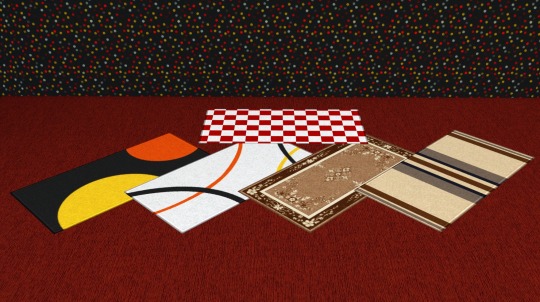
🎄 DAY 2: Cozy Patio Table
I made this table using the legs from the "Deluxe Cozy Terrarium" from Outdoor Living, then put a glass top and voila! A cozy patio table. Five slots as with any 1x1 dining table with one channel. Found in Surfaces > Dining Tables, costs §200.

🎄 DAY 3: 4to3 Snowy Escape "Bamboo Forest Fence"
Yep, we are still lacking various fences in TS3, hence converting this gem from Snowy Escape. Three channels, costs §25. Found in Build mode > Fences.

🎄 DAY 4: 4to3 "RAW Utensil Holder"
For the clutter lovers, here's something for your kitchen, if you also love the industrial accents from TS4 like me. Four channels, costs §430, found in Decor > Sculptures, Misc.

🎄 DAY 5: 2to3 Kitchen & Bath "FaceBowl by Sleek Sensations"
This conversion took almost a year in the making and thought would never get finished, but here it is, finally ready to conquer your bathrooms! Four channels, costs §670, found in Plumbing > Sinks.
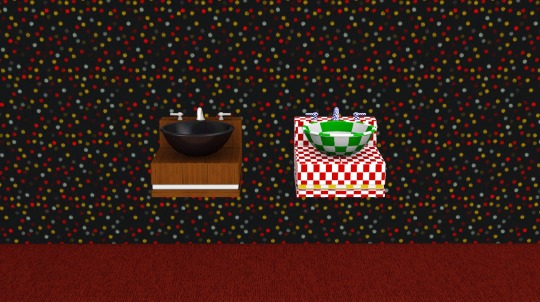
🎄 DAY 6: Outdoor Living "Class-E Dining Table" Unornated
I love the stuff from Outdoor Living, but why didn't EA make un-ornated versions of the furniture for variety? And so I did the work. Same channels and slots as the original, only differs in price which is now §825. Found in Surfaces > Dining tables. Outdoor Living not required.

🎄 DAY 7: 2to3 Apartment Life "BLOK Jr. Block from COGnition"
I miss the industrial/gearhead aesthetic from TS2:AL and this wall is one of those, so I converted it. Three channels, costs §11, found in Walls > Panelling.
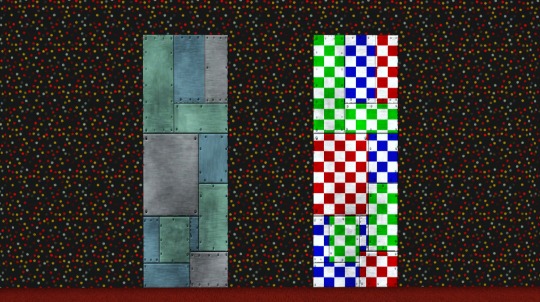
🎄 DAY 8: Outdoor Living "The Poet's Respite" Unornated
Another un-ornated piece of furniture from Outdoor Living (I just couldn't stand the cursive elements sometimes @.@). Lowered the price to §300, everything else is left intact. Outdoor Living is also not required.

🎄 DAY 9: 2to3 Kitchen & Bath "Pots Descending from Ceiling"
I hate repeating myself, but yeah it's nostalgia that's the main reason why I convert 2to3 items. Especially from this stuff pack, I'd love to convert everything else left unconverted from it (but the counters stop me from doing so). Two channels, costs §160, found in Decor > Sculptures, Misc.
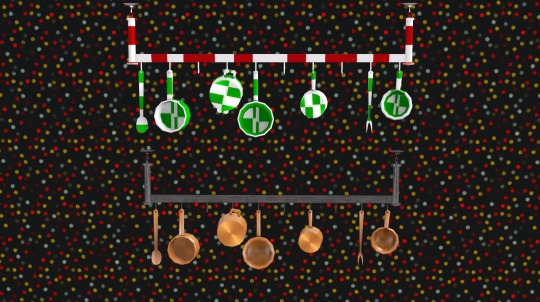
🎄 DAY 10: 4to3 Max20 Shark Plush Toy
I've been pondering if I should put this one up for download, because I couldn't find the original cc post to link. But having seen this 4to2 conversion, I figured I should also share it. Two channels, costs §100, found in Decor > Misc, Kids > Misc. Credits to Max20 for the original TS4 creation.

Fun fact: I own a real life counterpart of this plushie (I got this as a secret santa gift), and now my cat has already claimed it as his property. 🐱🦈

🎄 DAY 11: Ambitions "Le Sconce" made fully CAStable
I hate it when EA decides to make an object part unrecolorable when there are actually many ways to redesign it, like in this default replacement I did on a mirror. This wall lamp now has the emblem CAStable, and also edited the mask into three channels for a more versatile recolorability. This is a default replacement, so you need Ambitions for this to work properly.

🎄 DAY 12: 4to3 "The Centurion"
Need something to fill your dining room but too lazy to decorate it using shelves and clutter? Say no more! This pre-decorated hutch from TS4 is now also available for TS3! Three channels, costs a hefty §1880 (why EA?), found in Decor > Sculptures.

POLYCOUNT INFO:
Tres Rugs by Sleek Sensations: 80 (hLOD)
Cozy Patio Table: 526 (hLOD)/220 (mLOD)
Bamboo Forest Fence: 44 (main)/48 (diagonal)/12 (post)
RAW Utensil Holder: 250 (hLOD)/220 (mLOD)
FaceBowl by Sleek Sensations: 1356 (hLOD)/877 (mLOD)
Class-E Dining Table Unornated: 750 (hLOD)/257 (mLOD)
The Poet's Respite Unornated: 994 (hLOD)/360 (mLOD)
Pots Descending from Ceiling: 2122 (hLOD)/1190 (mLOD) (!!!)
Max20 Shark Plush Toy: 750 (hLOD)/444 (mLOD)
The Centurion: 420 (hLOD)/360 (mLOD)
DOWNLOAD FOLDER: Simfileshare | Mediafire
*All converted items contain catalog descriptions from their respective original games.
**I would also like to thank @simlicious for her wonderful selection of Christmas themed patterns, one of which I used on the wall in the previews, found here. Please check out her website if you haven't yet..
#ts3cc#download#dl:buy#dl:build#dl:defaults#sims 3#ts3#4to3#2to3#ts4 to ts3#ts2 to ts3#simblr#sims 3 cc finds
172 notes
·
View notes
Text
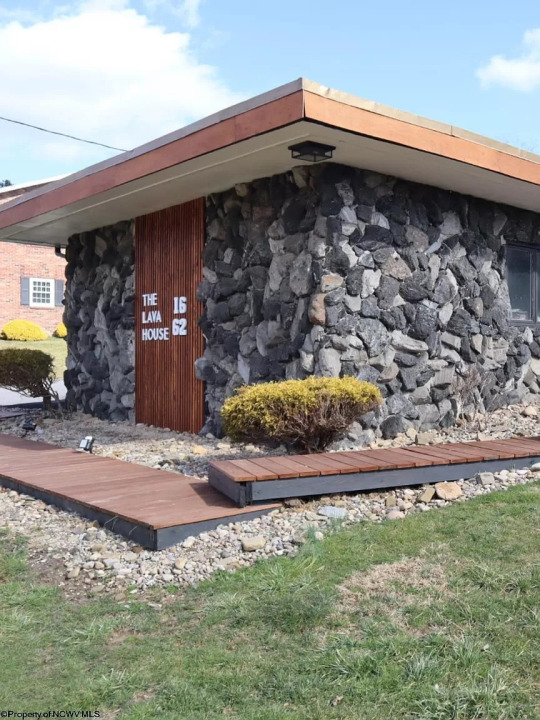
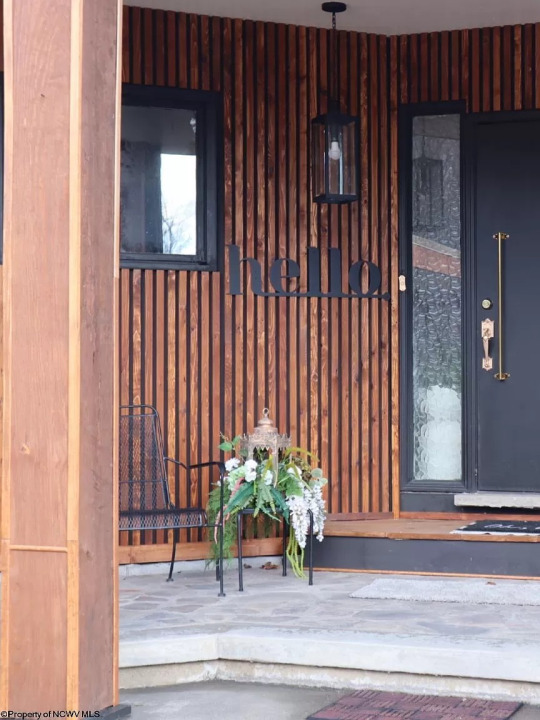
According to the description, the current owner loves and cherishes this 1968 mid-century modern home in Fairmont, West Virginia, and it shows. Wonder why he's selling it. 4bds, 4ba, $729K.
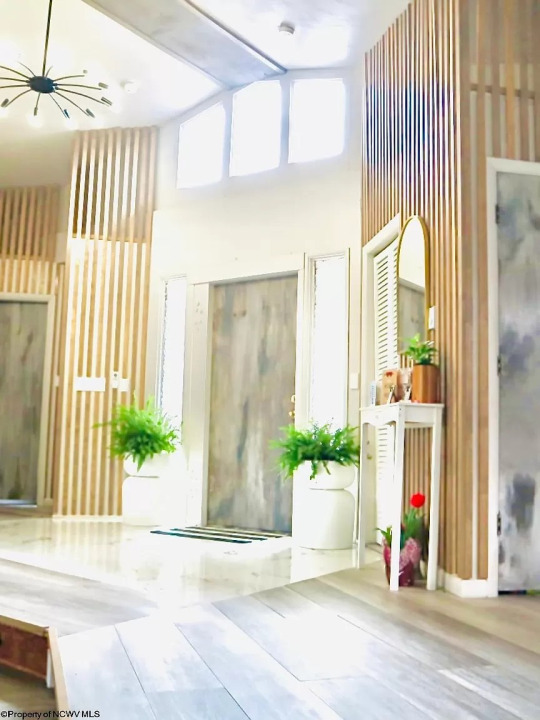
Very different entrance. It has wide, gray, plank flooring and stick walls, which you never see in MCMs. Also, look at the simulated worn finish on the doors.
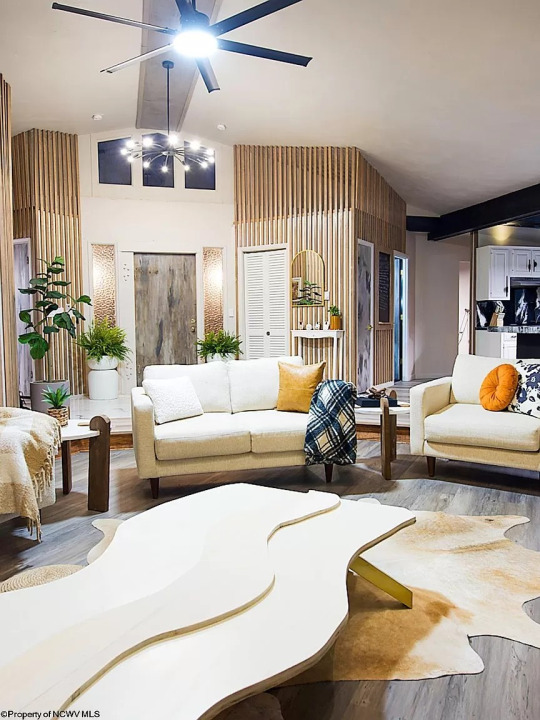


The home is very chic. On the exterior wall is a sign that says "Lava House," so I'm assuming that the fireplace is made from lava rock. Note the white board that says, "Welcome to our Beautiful Home."



Love the black & white kitchen, especially the blacksplash, counters, and ceiling. I'm so bored with the HGTV designers choosing basick pure white counters. This is stunning.

Here's a little bar in the corner with a rock wall and artsy ceiling. The window wall looks like a gold mesh and the colorful drapes really set it off.
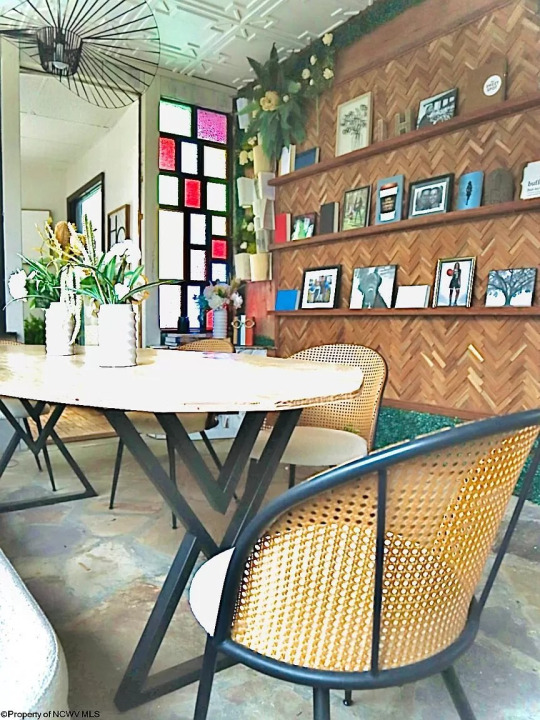
The dining area has the same ceiling as the kitchen's but it's painted white. There's a nice MCM colored glass panel in the wall, also. So many touches, like the herring bone wall and shelving.

This is amazing- a wall of old books, moss and flowers. That looks so lovely. I've seen this before, but never with plants.
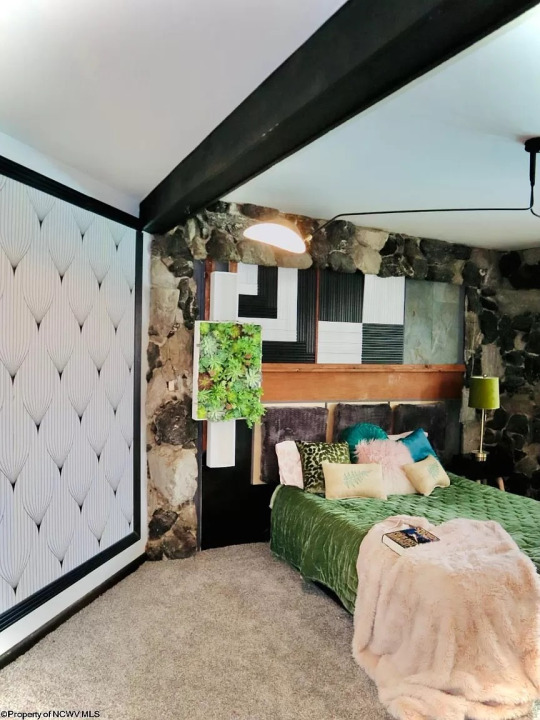
The walls in the primary bedroom are so interesting. Every one is different.


This home is a work of art. It even has a gray toilet.

Huge secondary bedroom with 3 stripes on the walls and ceilings.
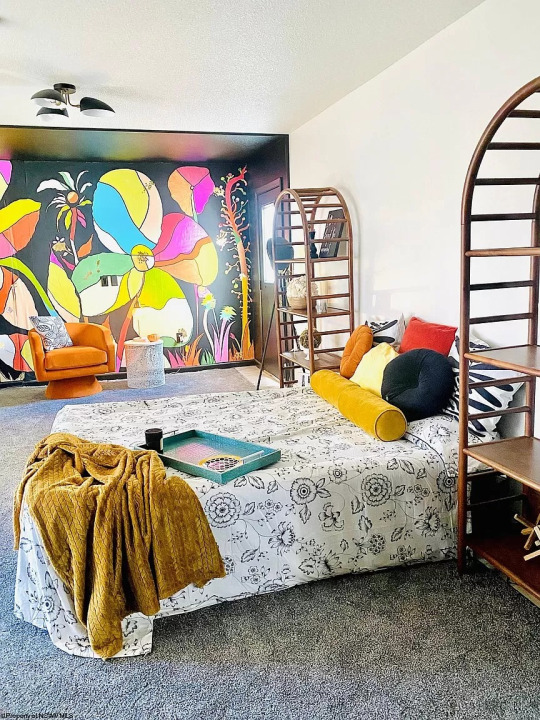
Now, there's a very 60s mod mural.
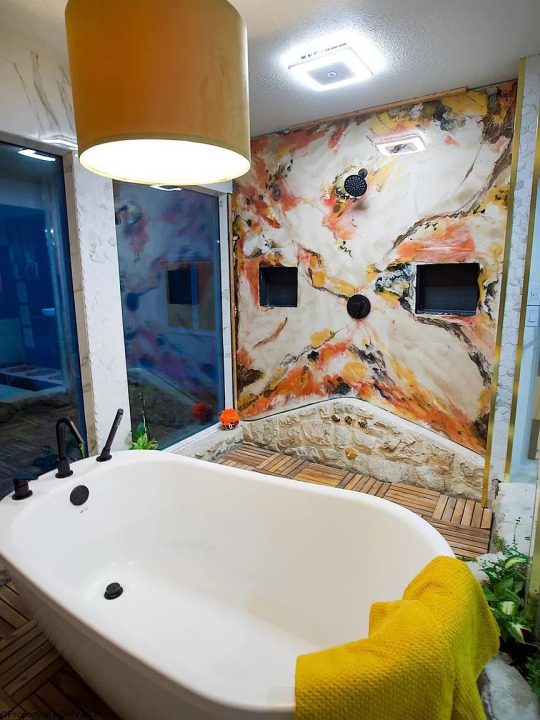
Look at the shower in this bath. HGTV would shit.

The rooms in this home are so big. The family room floor looks like it's cement. The walls look like they have a bamboo or straw paper, and how cool are those pocket doors?
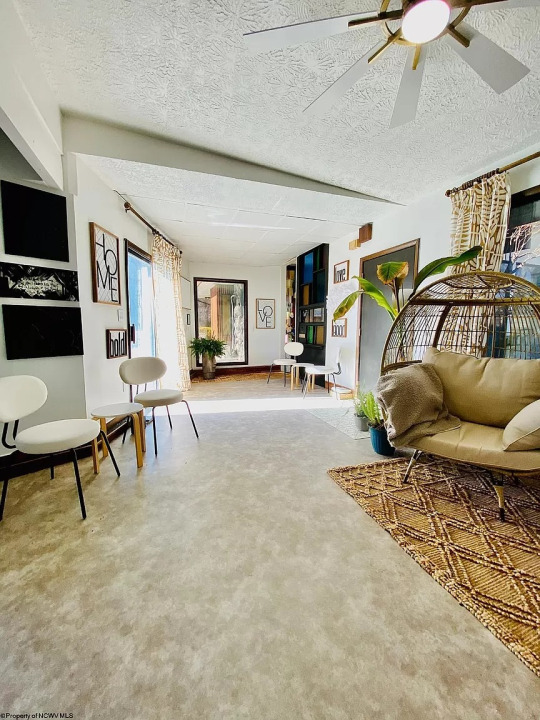
I don't think I've ever seen this much texture in any other home.

Look at how fun and bright the 2nd kitchen is.

These owners were not afraid to experiment and go bold, and it paid off.
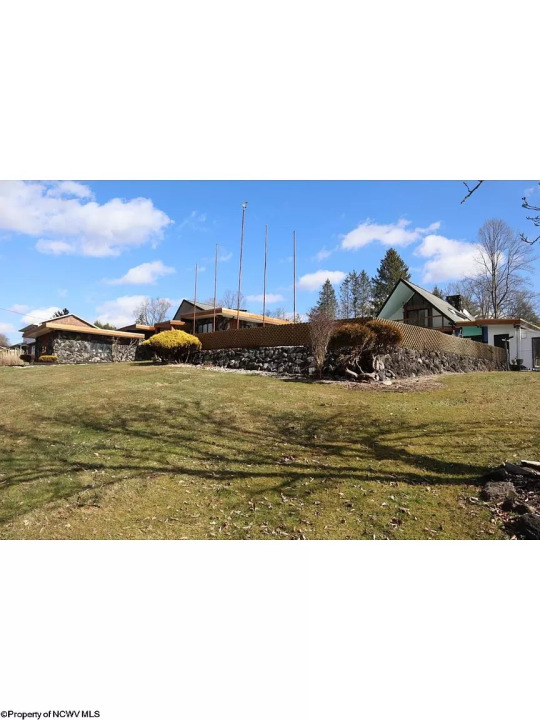
The lot is a little over an acre, but the yard is private and fenced in.
https://www.zillow.com/homedetails/1662-Fairmont-Ave-Fairmont-WV-26554/22729697_zpid/
154 notes
·
View notes
Text

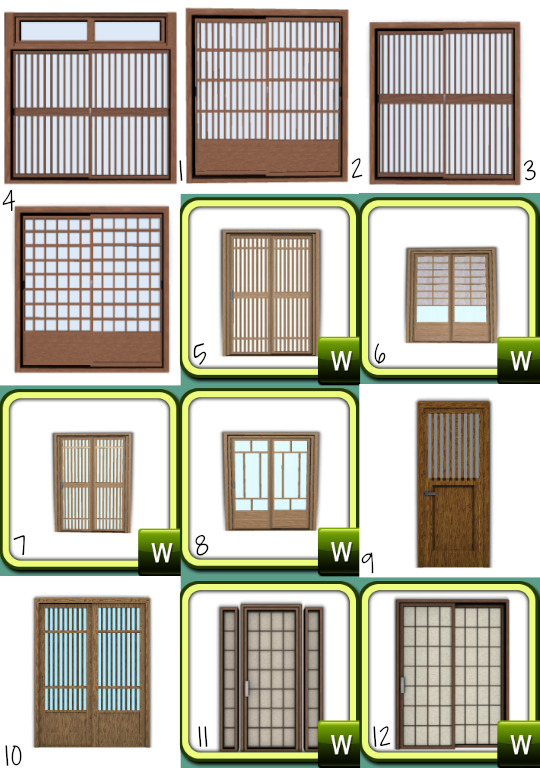
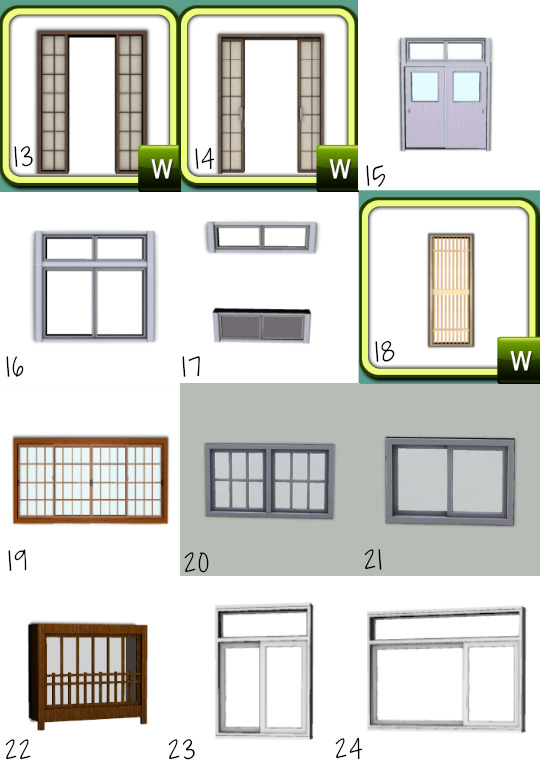

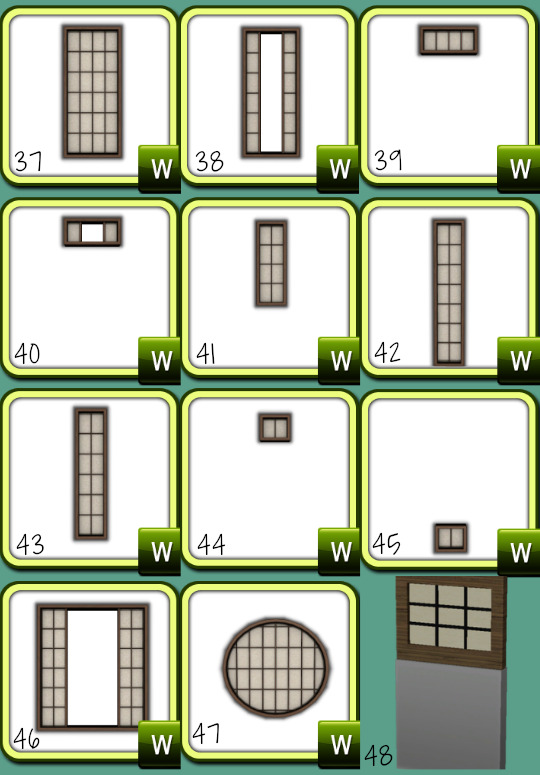
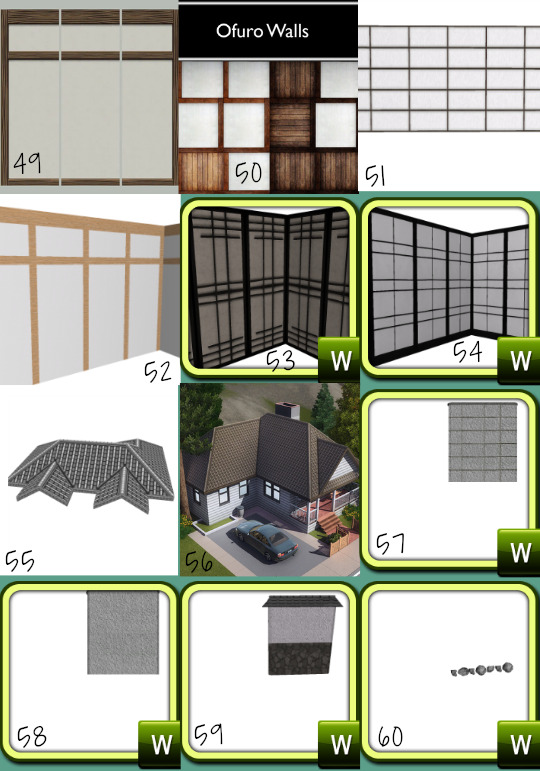

WanderingSims Face CC - Asian Build List
1-4 - simnaru - Japanese Entrance Double Sliding 2x1 Doors 4-7
5-8 - Sugichaco - Door 01-04
9 - Martassimsbook - The Sims 4 Snowy Escape Mountain Sun Door
10 - Martassimsbook - The Sims 4 Snowy Escape Ssh! Shoji Sliding Double Door
11, 13, 28-36 - Mutske - Tokyo Windows Part 1 (TSR)
12, 14, 37-47 - Mutske - Tokyo Windows Part 2 (TSR)
15-17 - simnaru - School Build Set (Door Sliding 2x1 School, Window 2x1 School 1, Window School 2)
18 - Sugichaco - Japanese Window 01
19 - simnaru - Japanese Syouji Middle Set
20 - Martassimsbook - The Sims 4 Snowy Escape Double Sunrise Window
21 - Martassimsbook - The Sims 4 Snowy Escape Is It Snowing Slider Window
22 - Martassimsbook - The Sims 4 Snowy Escape Shoji Style Window in a Box
23-27 - Martassimsbook - 4t3 Sims-KKB Ordinary Windows Set
48 - Blams - Rice Paper Wall
49 - Martassimsbook - The Sims 4 Snowy Escape Summit Cedar Walls
50 - Milla - Lama Ofuro Set Wall 4 & 5
51 - sim_man123 - Akiho Wall Paneling (TSR)
52 - Devirose - Japanese Modern Wall 1 (TSR)
53 - Devirose - Wall Asian Closets Coordinated (TSR)
54 - Devirose - Wall Asian Shoji 1 (TSR)
55 - simnaru - Japanese Roof
56 - boringbones - Japanese Roofs
57-59 - simnaru - Fence Japanese 1 & 2 and Fence Roofed
60 - SIMCredible! - Asian Nook Fence (TSR)
61-62 - Luna - Fence Bamboo 0 & 1
63-66 - Martassimsbook- 4t3 Syboulette Pioupiou Set (Fence, Tall Fence, Single Gate, Double Gate)
67 - sim_man123 - Small & Large Japanese Maple Trees (TSR)
68 - sim_man123 - Small & Large Japanese Pine Trees (TSR)
69 - sim_man123 - Small & Large Japanese Cherry Trees (TSR)
70 - mwthsims3 - Cherry Tree Default Replacement
200 notes
·
View notes
Text
Ohan’Ali Dock West
(CC List + DL)
[Note: (1) If your sims keep taking off their shoes and you do not want them to, individually click the Charly Pancakes shoes, located within the primary bedrooms of both houseboats, to get the menu to turn it off. (2) There are mini fridges slotted into both kitchens!]






















World Map: Sulani
Area: Ohan’Ali
Lot Size: 30 x 30
Capacity
Houseboat 1: 2 Bedroom (Up to 5 sims), 1 Bathroom (w/ bathtub), Kitchen, Living
Houseboat 2: 2 Bedroom (Up to 6 sims), 1 Bathroom, Kitchen, Living, Bar Room, 2 Entertainment Decks
Gallery ID: Simstorian-ish
Packs Needed
Expansion Packs
Cats & Dogs
Cottage Living
Get Famous
Get Together
Get To Work
Growing Together
High School Years
Horse Ranch
Island Living
Lovestruck
Snowy Escape
Game Packs
Dream Home Decorator
Realm of Magic
Spa Day
Star Wars: Journey to Batuu
Strangerville
Vampires
Werewolves
Stuff Packs
Home Chef Hustle
Laundry Day
Toddler Stuff
CC Used
[All credits go to the following creators for sharing their work with the community. It is greatly appreciated and I hope that you all have endless nights of the best sleep ever.]
Helpful Tip: Having Only What is Needed For CC Builds (Tumblr)
Amoebae: Pile in Carpet
Anye: Neomy (Rug)
AroundTheSims4: Awning Set
Awingedllama: Blooming Rooms Separated
Charly Pancakes: Lavish, The Lighthouse Collection
DSC: Fancy Table Setting
Felixandre: Soho Pt. 1 | 5 (CurseForge)
GUA Sims: Apricity (Curtains + Tracks)
Harrie: Brownstone Pt. 1 (Shelves), Coastal Pt. 5|8, Country Kitchen, Klean Pt. 2, Octave Pt. 2|3|4
House of Harlix: Bafroom (Hot Tub), Harluxe, Kichen, Kichen 2.0, Livin’ Rum, Orjanic Pt. 1 (Sliding Oak Door Medium), Orjanic Pt.2 (Rug)
KKB’s: JOMO Laundry
Max20: Closet Collection
Lili’s Palace: Folklore (Deco Wheel on Wall 1)
LittleDica: Chic Bathroom, Rise & Grind Cafe (Fence 1)
NANDO: Fashion Store (Mirror Large)
NoStyle x Woodland: Rumasri Petbed
Pierisim: Auntie Vera Bathroom (Bathrobe), Domaine Du Clos Pt. 2|4, MCM Pt. 2|3|5, Oak House Pt. 1 (Coat Hanger), Outside Lunch, Pantry Party
Peacemaker: Arcadia, Bayside Bedroom (Dresser), Creta Indoor & Outdoor Kitchen (Urned Palm), Drapery Delights, Hickory Floorboards, Hamptons Hideaway, Hamptons Retreat, Hamptons Getaway, Hinterlands Dining (Round Dining Table), Hinterlands Living (Sectional+Chaise), Hudson Bathroom (Hamper), Kitayama Dining (Dining Chair), Volta Appliances (Under-cabinet Rangehood), Simple Siding
Plush Pixels: Shape Collection, Summer Closet
PXL: RH Baby & Child Bunk
Ravasheen: CounterFit (Mini Fridges +Trashbin), You Know the Drill (Thermastat)
RubyRed: Beaded Pendant Large
RusticSims: Kind of Modular (Books 4)
SicamCC: Life in Plastic (Vanity Chair)
Sooky88: Leaning Framed Posters – 2 Frames
Sundays: Cirrus Pt. 1|2|3, Java Pt. 1(Throw Blanket), Kediri Pt. 1 (Throw Pillows), Kedungu Pt. 1 (Throw Pillow I), Kelapa Pt. 1 (Throw Blanket), Nisaki Pt. 3, Pool Haus Pt. 1|4 (Armchair + Bar Stool), Sumba Pt. 1 (Pillow Set I + Throw Blanket), Ungasan Pt. 2 (Slippers)
Syboubou: Bamboo Foundations, Elevare (Industrial Stairs + Top)
TheClutterCat: Casita (Feeding Bowl), Fairylicious, iCare, iLove, Snuggle Set Pt. III (Wooden Candle Tray), Sunny Sundae III (Books), Welcome Home I | II
TaurusDesign: Lilith Chilling Areas Pt. 1|2
TUDS: Cross (Lamp Ceiling M), Ind 03 (2x2 Round Table), NCTR (Wallpaper Panel), Turn
Valia: Beachy, Cozy Cabin Nursery
Wondymoon: Carpinus Living Chair (website not available)
DO NOT REUPLOAD MY LOTS.
DO NOT CLAIM THEM AS YOUR OWN.
DO NOT PLACE BEHIND A PAYWALL.
DOWNLOAD (1.56 GB)
#simstorian#the sims 4#sims 4#ts4#sims 4 build#ts4 simblr#sulani#showusyourbuilds#showusyourdecor#cc build#maxis mix
36 notes
·
View notes
Note
Ok so inspired by the smiling headcanons you just did, could you write a nsfw oneshot for Barnes involving overstim and/or teasing?? 👀👀 thank yew!


Pulling The Trigger.
Robert Barnes x Reader.
---
You develop the odd tendency of getting up at 0400 to have a shower.
Reason being; solitude.
Devoid of the scramble of who gets to the water first and who pushes who into the makeshift palette fence adjacent to the barracks in a rush to get to the refreshment soonest, along with just a million 'drop the soap' jokes, whistling, jeering, lewd, splashing, comments and laughing even from the men directed at each other, just about the last thing you wanted was to try your luck at the Herculean task of showering alongside a bunch of them while outnumbered the way you were --- so at the crack of dawn it was. For months now, not that you kept an exact count. The whole basecamp vaguely asleep except however the night watch, the trip to what effectively served as a water closet in the relative wilderness was fairly uneventful, just the way you wanted it; nobody saw you do it. Nobody saw you right in the midst of it. Nobody would see you finish and return to your bunk either. But, it was something that needed to be done regardless how much you put it off, lest you acquire a pathetic case of lice. So, you hurry. The way you always do, standing on a small cement pad fenced off and tall enough to cover your body with just about the top of your head visible, you grab the nearby bucket and pour it over yourself once you're stripped, your fatigues throw over the nearby rail of the mobile shower, a nearby 55 gallon barrel of water ensuring you won't damage the other's prospects of achieving refreshment too.
Cold.
It was cold.
Luckily, even at daybreak, the air managed to be so humid already, your body didn't mind, regardless, due to natural instinct, it shivers, trickling down the top of your head and your spine, dripping down your legs impatiently tapping in place. A partially melted bar of soap with a long hair stuck to it that definitely wasn't yours, an old washcloth, a partially cracked mirror hanging off the fence attached there by an old bit of rope and wiring and not much else except the open sky above you; your eyes squinted shut once the water hits you and you're grateful even for this much, rubbing your lids dry and clean with your fingers. Being clean. The one thing that made you feel human out here. Then, when a voice speaks up from the other side of the fence, startling you, you feel more than human; you feel like a startled animal, snapping your eyes open, practically jumping.
-"You gonna be headin' out at 0600 so get your shit ready."-
All business and no shame, Sergeant Barnes staring right at you.
Already dressed, already awake. Already smoking too.
-"Oh, god!"-
You didn't mean to be a blushing wall flower, but an impulse was still an impulse, and your impulse then bids you to nearly shriek, placing your hand over your mouth to avoid making any sound that would be loud enough to echo across the quiet, still sleepy camp. When did this man wake up!? Three in the morning!? Two!? Did he ever even sleep at all!? -"Oh, god, I'm so sorry, sir, it's just that I didn't expect anyone to be here at this hour."- You ramble, apologizing, justifying yourself, your mouth moving on your own accord like a robot practically wired to do so, even though you were there stark ass naked and he was the intruding party; not that there was such a thing as intrusion out here. The men spoke to each other in various states of undress all the time and you supposed if you wanted to be equal...-"Sorry."- You manage to mutter out, finding some relief by sitting down on the concrete pad, hiding some semblance of your nudity in a rush. Actually reaching out to grab your own fatigues off the fence just inches away seemed like a tall order; and it was, not without flashing him your entire torso along with your full frontal self. He slowly approaches the bamboo panel that separated the two of you, lips pursed as they coiled around his cigarette. How could someone so big be so quiet? How did he even get this close to you without ever noticing? Ever hearing? -"Stand to attention when talkin' to me."- He says, leisurely, and that was an order, you knew as much. -"Of course."- You mumble out another apology, not realizing this briefing was formal in nature, hands scrambling for your uniform in an attempt to get dressed even though your were dripping wet. Even though you'd soak the material. His hand claps yours over the material, stopping it there, the index finger of his other hand wagging, giving warning.
-"And you stick by me out on trek, you hear? Me. No one else."-
Barnes instructs firmly, placing special emphasis on the 'me' part.
First time out on patrol with the men, you were inclined to listen.
You couldn't deny you were actually as nervous as they come.
Perhaps part of the reason why you were having this shower in the first place.
Maybe, subconsciously in many ways you feared and dreaded it could be your last.
-"I'll be wantin' to see right where you are at all times so your ass don't go gettin' lost on me out in the bush."-
He adds strictly, brows furrowed, looking straight at your face.
Never lower.
You simultaneously feel fully bared and entirely clothed.
Vivisected like a piece of meat and yet entirely formal, all hierarchy.
-"Understood. Perfectly clear, sir. Thank you, sir."-
You gulp, nodding reverently, wet strands of hair dripping across your shoulders.
He never did warn anyone of anything, having a 'sink or swim' approach.
Especially with the new guys, tossing them right into the fray.
So, why he was telling you this in particular...well, it was beyond you.
-"Nervous, first timer?"-
He asks suddenly, almost like his tone of voice fell from a staunchly professional one, almost paternal in its reprimand, an octave lower, to something more personal. You shake your head wordlessly, even though it was clear that your present predicament was tense enough to split atoms. -"Stressin' 'bout sumn'?"- He presses once you say nothing, head tilted downwards, towards you and you swear to god, Barnes is grinning. Barnes is grinning. You? Stressing about something? More like stressing about everything? -"No, sir."- You decide to lie, avoiding his gaze; sure, you were stressing about the fact that you were getting deployed out into the jungle with a platoon of men, never having done so before and that you were standing here naked with your superior officer while his hand was clasping yours over a water drenched uniform that carried the imprint of your shivering fingers. There was also the notion that you could've said you found the man striking ever since you were stationed here, but decided to keep your admiration strictly personal and now, he was so close the smoke of his cigarette was hitting you in hot waves. -"Ah, quit'yer lyin', cherry."- He drawls jovially, like he didn't buy the bullshit, letting go of your hand suddenly. The absence of him is so cold you simultaneously feel relived just as much as you want to die on the spot. Maybe in several hours time, your wish would come true. -"I've seen the way y'look at me."- Barnes leisurely saunters straight into the shower, boots on and fully dressed; now he was facing you, no barriers between you. His words perturbing enough that you momentarily disregard the fact that he could see all of you. He could...see the way you look at him? How!? When you went out of your way to keep it to a respectful minimum. -"Excuse me, sir?"- You stutter out, trying to maintain some composure; another ordered that proved to be too tall when you realized he was not only standing there, he was also approaching you, slowly, one step at a time. Cigarette smoked down to the butt, he crushes the remains under his bootheel, promptly stepping on it, leaving it there crushed and deformed in a puddle of shower water.
-"Thing is, don't want'ya to be starin' at me when you should be starin' ahead and all around'ya at all times. That's how y'earn yourself a ticket right out of here in a body bag."-
He explains, sounding uncharacteristically soft, however smug he came off due to the contents of his words, you don't think you've ever heard Barnes sound so tender and truth of the matter was, you were staring, the button up green dress shirt of your fatigues pressed to your chest for comfort. You were staring, right in this very moment. Thinking how very handsome he must've been in a bygone time before whatever blast came around disfigured his face; you figured so, because even close up, this instant, with all the damage done to him, he was still very handsome. Albeit frightening. Like something not meant to be touched. Your legs shake.
-"So, imma do sumn' 'bout that."-
He warns and you never even notice when you're grabbed and spun around, your chest pressed against the bamboo wall, face to face with the surface of the small shaving mirror your cheek's brushed up against; that was the thing about Barnes you observed in the past few months --- he was too quiet to be avoided, too quick to ever really be intercepted, coming and going like he wasn't even there. His reflection is behind you, reflected in the mirror and you see his see his scowl looming from over your shoulder, a quick hand's motion wiping away the droplets of water caught on the glass. Your heart beats wildly. Out of order. About to burst out of your chest. -"Look at it!"- He barks, shaking you.
-"Have yourself a good stare!"-
He commands sharply, chin nestled into the crook of your shoulder, your arms clasped behind your back in a vice grip, bare ass pressed against his crotch and it takes a moment for you to realize he meant his scar. He wanted you to look at his scar. Did he...think you were sneaking peeks at him periodically and that it was distracting you from your surroundings? That's...not why you were occasionally looking. But, one couldn't just come out and say 'Sir, if I look it's because I find you a marvel to look at'. Not here. Not now. Not when you were scared shitless. Lacking all courage. All bravery depleted.
-"When's the last sumn' cleared up'ya head so you don't go driftin' off in the fog? Hmm?"-
That 'hmm' is guttural, deep, almost a query and a tease as you feel a thick, meaty finger part the lips of your cunt, like silk to sandpaper, causing you to sharply draw in breath, realizing he was just asking you when's the last time you got fucked into clarity. Into a state of focus. Rattled just enough to be mindful. The opposite of distracted. Anxious. Fidgety. He starts rubbing and your body bucks into the movement, your face stuck to the mirror, watching him watching you. -"Daydreamin' will get'ya killed."- His words are hot in your ear, the textured pattern of a scarred mouth pressed against your lobe. -"Lollygaggin' will get'ya killed."- He adds, like a steady mantra.
Fingers repeatedly drawing eights into your folds.
Feverishly quickly, like he was trying to build you up as fast as possible.
-"Absentmindedness. Gets'ya killed."-
Barnes continues, his fingers working up a sweat in you, erupting your parted mouth in a cacophony of moans and sighs, leaving a trail of hot mist on the surface of the cracked mirror, causing your stomach to tense and coil; funny how it took so little to turn you on; his fingers weren't between your lips all but some odd ten to fifteen seconds and you already felt like you could explode. Either you were deprived of it too long to nervous degrees or you liked him so much that even very little was more than enough. Both were simultaneously possible too. -"Woolgatherin' gets us --- what?"- You whimper as he inquires, this time around in plurals, but your mind is too far gone to answer with any concise meaning, so he does it for you, never stopping with his ministrations; odd the warmth of the act not matching the heaviness of his words. His arms around you are are balmy and sweltering, his nicotine laced breath against your face, his chest against your back, all of it is clement and oddly snug except what he was saying. Woolgathering gets us... -"Killed."- He says simply, the finality of that spinechilling; you understand he was trying to relay --- get fixated on an idle fascination, a crush, an attraction and neglect the here, the now, and it can cost you your life. Instead, get it over and done with. Get it out of your system. Rub it out like a strange itch and he does so too, massaging your cunt you differently than he would a ready trigger about to be pulled. You groan once you feel the build up's epilogue, instinctively, your trapped arms writhing in his grip and just were you thought you were about to cum, he stops, pulling back, leaving you hanging and out of breath. You feel hazy yet somehow, more attuned to reality than ever. His face is the mirror and he observes you steadily from behind your back, ever focused. You don't know what compels you to press your lips against the surface of the glass and kiss his reflection, but you do. The imprint of your lips smeared across his visage. It was no different from kiss a sweetheart's picture nestled in a wallet. The gaze he gives you is soul piercing for all but a second before he's fined-tuned again, running at a perfectly controlled optimum while you were there reeling, practically pulsating with unquenched need, as wary as an animal. -"Get dressed."- Is all Sergeant Barnes says.
You kneel, disobeying a direct order, grabbing a hold of his trousers in the process.
You wanted, no, needed to return the favor, right here, on this concrete pad.
Bare, wet knees against the rock; not prudent, not smart. Wanton, though?
Yeah.
You were about to scrape and bleed yourself purely to feel him in your mouth.
Get at least some finalized relief through that.
Possibly the only man alive postponing or effectively rejecting the prospect of a blowjob being offered freely, his hand still slick and shiny with the wetness of you pulls you up with ease, like you weighed nothing at all, the fabric of his fatigues a muted olive green where you haven't touched him and dark where you soaked him through sheer contact. His stare is serious in its discipline. Stern, even. Like he was trying to relay the notion that right now, you were the one in ample, desperate need of this. Not him. You were the misplaced cog that was rattling around inside of the engine and required fixing. He didn't need fixing. Not at the present anyway.
-"When I need it I'll come get it."-
All transparency and all business, Barnes made no promises he didn't eventually keep. You knew as much. What's funniest, though? As he leaves you, giving you a lingering look, you feel strangely happy. Elated. Hastily putting on your fatigues, edged and rattled, you smile, looking forward to it. Looking forward to when he'll need it too.
#platoon#platoon 1986#platoon imagine#platoon imagines#platoon headcanon#platoon headcanons#platoon reader insert#platoon reader inserts#robert barnes#bob barnes#robert barnes x reader#bob barnes x reader#robert barnes imagine#robert barnes imagines#bob barnes imagine#bob barnes imagines#bob barnes headcanon#bob barnes headcanons#robert barnes headcanon#robert barnes headcanons
22 notes
·
View notes
Text
Full Round Roll of Bamboo Cendani, Bamboo Garden Fence Rolls Panels Bamboo Garden Buildings Fencing Trellis & Gates Fence Panels
0 notes
Text
Full Round Roll of Bamboo Cendani, Bamboo Garden Fence Rolls Panels Bamboo Garden Buildings Fencing Trellis & Gates Fence Panels
0 notes
Text
Fencing Poles: The Ultimate Guide to Durable and Secure Boundaries
Fencing poles play a crucial role in establishing strong, secure, and long-lasting boundaries for residential, commercial, and agricultural properties. Whether you are securing farmland, protecting a construction site, or enhancing security around a property, choosing the right fencing poles is essential. In this guide, we will explore everything you need to know about fencing poles, including types, materials, benefits, and installation tips.
What Are Fencing Poles?
Fencing poles, also known as fence posts, are vertical structures that support fencing materials such as chain-link, barbed wire, concertina wire, wooden panels, or metal mesh. They provide stability, durability, and structural integrity to the fence, ensuring it remains upright and resistant to external forces.
Types of Fencing Poles
There are various types of fencing poles available in the market, each designed for specific applications. The most common types include:
Concrete Fencing Poles
Made from reinforced concrete, these poles are extremely durable and resistant to weather conditions.
Ideal for long-term security fencing, boundary walls, and agricultural land protection.
Require minimal maintenance and are highly resistant to termites and rot.
Steel Fencing Poles
Made from galvanized or stainless steel, these poles offer exceptional strength and durability.
Commonly used for chain-link fencing, security enclosures, and industrial applications.
Resistant to corrosion, fire, and impact damage.
Wooden Fencing Poles
Traditionally used in agricultural and garden fencing, wooden poles provide a natural and aesthetic look.
Require periodic maintenance, such as painting or sealing, to prevent rot and insect infestation.
Available in various wood types, including pine, cedar, and oak.
PVC or Plastic Fencing Poles
Lightweight, cost-effective, and easy to install.
Resistant to weather damage, rust, and insect attacks.
Suitable for residential gardens, decorative fencing, and temporary enclosures.
Bamboo Fencing Poles
An eco-friendly alternative, bamboo poles are lightweight and biodegradable.
Often used for decorative fencing, garden enclosures, and temporary barriers.
Require protection against moisture and pests.
Advantages of Using Fencing Poles
Fencing poles offer numerous advantages that make them a preferred choice for securing properties. Some key benefits include:
Enhanced Security: Strong and durable fencing poles provide a reliable barrier against trespassers, wild animals, and unauthorized access.
Property Demarcation: Fences supported by sturdy poles clearly define property boundaries, preventing disputes.
Durability: High-quality materials such as concrete and steel ensure long-lasting protection.
Low Maintenance: Unlike traditional wooden fences, materials like concrete and steel require minimal upkeep.
Weather Resistance: Properly chosen fencing poles withstand harsh weather conditions, including rain, heat, and extreme winds.
Customizable Designs: Available in various heights, materials, and finishes, fencing poles can be tailored to match specific aesthetic and functional needs.
Factors to Consider When Choosing Fencing Poles
Selecting the right fencing poles depends on several factors:
Purpose of the Fence: Consider whether the fence is for security, decoration, agriculture, or temporary use.
Material Durability: Choose materials that suit the environmental conditions and expected wear and tear.
Height and Thickness: Taller and thicker poles provide more strength and security.
Installation Cost: Consider the initial investment and long-term maintenance costs.
Local Regulations: Ensure compliance with zoning laws and building regulations before installing fences.
Installation Process of Fencing Poles
Proper installation is key to ensuring the longevity and effectiveness of fencing poles. Follow these steps for a successful installation:
Plan the Layout
Mark the boundary where the fencing will be installed.
Measure and space out the pole positions evenly (typically 6-8 feet apart).
Dig the Post Holes
Use a post-hole digger to create holes that are at least 1/3rd the height of the pole.
Ensure the depth provides stability against external forces.
Set the Poles
Place the fencing poles in the holes and ensure they are upright using a level.
For concrete poles, pour a cement mix to secure them firmly in place.
For steel poles, use anchor plates or concrete footings.
Attach the Fencing Material
Depending on the fence type, attach chain-link mesh, barbed wire, wooden panels, or other materials.
Use fasteners, clips, or welding (for metal fences) to secure the fencing material properly.
Final Inspection
Check for alignment, spacing, and overall stability.
Make necessary adjustments before completing the installation.
Maintenance Tips for Fencing Poles
Regular maintenance extends the lifespan of fencing poles and keeps them in optimal condition. Here are some essential maintenance tips:
Inspect for Damage: Periodically check for cracks, rust, or loose fittings.
Clean the Poles: Remove dirt, debris, and rust buildup (for metal poles).
Repaint or Seal: Apply paint, sealant, or rust-proof coating as needed.
Reinforce Weak Sections: Replace or reinforce damaged poles promptly.
Ensure Proper Drainage: Prevent water accumulation near the base to avoid erosion and weakening.
Conclusion
Fencing poles are an essential component of any fencing system, providing the necessary support and durability for long-term security and property demarcation. Whether you choose concrete, steel, wood, or PVC, selecting the right material and installing it properly ensures a strong and reliable fence. By following the proper maintenance guidelines, you can maximize the lifespan of your fencing poles and maintain a secure boundary for years to come.
For high-quality fencing poles, always opt for reliable manufacturers like Indiawalls, ensuring superior strength, longevity, and cost-effectiveness. Secure your property today with the best fencing solutions!
0 notes
Text
Privacy, Security, and Style: Fence Installation Trends in Fairfield
Whether you are a homeowner or a store owner in Fairfield, you are in need of securing paramount fencing alternatives. The poor security measures implemented by the lockdown have created an opportunity for everyone. While the improvements in fencing technology and fencing products are for the better, you are always on the keen lookout for the best products to suit your security needs. Thus, potential buyers of fencing in Fairfield should consider what to be charging for the standards to either maintain or raise property values.

The Growing Demand for Privacy Fences
The owners of such property give high priority to privacy. When contemplating new fences, there is generally talk of solutions that don’t have to look like fences but bear the power to hide the comings and goingings. Taller wooden fences, vinyl or composites in panels are prevalent in the landscape just for that reason-viability and a style that has no bounds. The horizontal slats have increased in popularity because they seek out a highly chic, contemporary appearance that gives us the certain comfort we seek from a fence.
The common idea is the advent of hybrid fences, which combine elements of wood with metal for a contemporary, and tough outlook. These choices confer for privacy while allowing visibility, ventilation, and light.
Security-Focused Fencing Solutions
With security taking the most importance, many Fairfield residents are considering fencing for better security. They mostly pick steel as well as aluminum fences. This is a popular choice for their strength and ability to withstand elements. Homeowners are involved in state-of-the-art security equipment such as automatic gates, smart locks, and even cameras in order to be integrated with the fencing.
High-security fencing featuring anti-climb attributes and heavy-duty materials are now regarded as a norm for commercial properties. Chain-link fences are fitted with privacy slats, welded wire panels, and electric fences for heightened security in the light of commercial and industrial interests.
Stylish and Sustainable Fencing Options
Fencing is actually a visual proposition, and all the variety of current trends aim to blend security with design. Wrought iron fencing or any other kind (of metal fence) will blend with the beauty and charm of the existing composition of the home; innovative work in stamped material; vinyl that comes in so many colors to be treated to look unique; composite fencing is one of the most fashionable options.
The business is also being influenced by sustainability. Materials like bamboo, e-til anthology of farming-harvested wood, and a co-invenine fencing-ready of reclaimed office application reclaiming plastics are increasingly being used. Their marriage of form equals function, from weighing down groundbreaking innovation, resistance, power, and unswerving maintenance.
Smart Fencing Technology
What Rebellion of Technology brings into Agricultural Solution is another way through which farmers are making their products to the consuming market and thus modern agricultural methods are defining a greater digital future run by technology in which robotics are playing an indispensable role. Agricultural Intelligence Systems containing electronics and software control the creeping/tracting farm machinery according to the particular part of the field.

Choosing the Right Fence for Your Property
Given the myriad of options, deciding on an ideal fence for a residential or commercial building in Fairfield requires a careful consideration of such factors as budget, maintenance, and use. Wooden fences create a timeless look but require lots of maintenance, while vinyl and composite fencing only requires occasional cleaning for durability. Metal fences have better security and longevity.
When it comes to Marine Epoxy installation services, remember one that can assist you with overall property inspection, identifying the mat railing solutions. The services of experienced installers will go a long way by enduring high-quality construction, which will yield better results for you.
Enhancing Your Property with the Latest Fencing Trends
As fencing trends continue to evolve, Fairfield residents have more options than ever to enhance their properties with stylish, secure, and sustainable fencing solutions. Whether you prioritize privacy, security, or aesthetics, investing in a well-designed fence can significantly boost your property’s value and functionality. If you’re considering a fence upgrade, consult with a trusted professional in fence installation Fairfield to find the best solution for your needs.
0 notes
Photo

Hi GPODers! We couldn’t avoid it forever. No matter how hard we hold onto fall, winter comes rolling along and for many of us that also means snowfall. Today’s photos come from Tingshu Hu and her husband Philip Zhao in Dunstable, Massachusetts. We’ve seen different aspects of their space during the peak seasons (Tingshu’s Front Garden in Late Summer, Summer in Tingshu’s Back Garden, Low Maintenance Garden in Massachusetts, A Space Created with Chinese Design Elements and English Garden Aesthetics, etc.), but today we’re getting a look at the interest Tingshu has managed to create even when the gardens are coated in a layer of snow. Four season interests, especially winter views, are essential for a home garden in New England, since we have 4+ months of winter, covered in snow and ice. The contrasts of colors and shapes against the white snowy background are still attracting us to go outside and explore the garden in winter. Snow came late this year. We received the first snow on December 5, 2024. Philip took some pictures while it was snowing. The centerpiece of the back garden is the Prairifire crabapple tree (Malus × ‘Prairifire’, Zones 4–8). Several pictures were taken going around the crabapple tree. There are numerous red berries on the crabapple tree, attracting many birds in winter. On the right side is a dwarf Colorado blue spruce (Picea pungens ‘Glauca’, Zones 2–8), lightly frosted in white snow. You can also see a pergola and garden fences through the tree branches. Looking from below the red crabapple berries, there are blue spruce, yew, azalea, bare branches of a dogwood, and an arbor. Further beyond, there are several pine trees. Looking from below an apple tree, with a bare branch hanging overhead, the crabapple tree, the blue spruce and a false cypress stand on the left. A magnolia tree, a Japanese maple (Acer palmatum and cvs., Zones 6–9) and a few azaleas stand above a stone retaining wall. There is a yew at the bottom of the photo. Looking west with the crabapple on the right, a false cypress stands between a white fence, and a tall purple fence of the vegetable garden. A grape pergola stands at the left side. View of the center of the back garden across a frozen fishpond. On the right side are the leaves of a clumping bamboo and a red twig dogwood (Cornus sericea, Zones 3–7). Curb appeals at the front garden: combination of pergola, fences and evergreens (rhododendron, false cypress and arborvitae), and an eastern redbud tree (Cercis canadensis and cvs., Zones 4–9) on the left. Outside the fence are a young Japanese maple, a gold cone juniper (Juniperus communis ‘Gold Cone’, Zones 5–7) and a dried maiden grass (Miscanthus sinensis, Zones 5–9). Our dog Luke is enjoying the sun after the snow. In front of Luke is a lotus in a mini pond, with dried flower heads and stems. On the left side is a clumping bamboo. The colors of Chinese mums (Chrysanthemum × morifolium, Zones 5–9) are visible from the glass of the green house. The fishpond under the pergola is frozen. All koi fish have been moved to a pond inside the sunroom under the solar panels. Chinese mums looking at the snow-covered front yard. Deep in the winter we may receive heavier snow. Then the garden will have very different looks. Back garden in January 2023, after a heavy snow. Luke went for a walk (Deedee was nearby but not in this picture). Front garden after a heavy snow in a previous winter. The eastern redbud is standing tall and proud, dressed with fluffy snow on its branches. Thank you for another incredible tour of your gardens, Tingshu! Winter interest is acquired with lots of foresight, and it’s clear that you’ve planned and prepared for snow-covered beauty to great success. Have you experienced the first snow fall of the season yet? Or is your garden already covered in a thick layer of ice and snow? Though the more subtle and subdued scenes of winter don’t necessarily have the same vibrant energy as peak season blooms, there is still plenty of interest and plants to admire and appreciate. Consider sharing your winter garden with Garden Photo of the Day! Follow the directions below to submit your photos via email, or send me a DM on Instagram: @agirlherdogandtheroad. Have a garden you’d like to share? Have photos to share? We’d love to see your garden, a particular collection of plants you love, or a wonderful garden you had the chance to visit! To submit, send 5-10 photos to [email protected] along with some information about the plants in the pictures and where you took the photos. We’d love to hear where you are located, how long you’ve been gardening, successes you are proud of, failures you learned from, hopes for the future, favorite plants, or funny stories from your garden. Have a mobile phone? Tag your photos on Facebook, Instagram or Twitter with #FineGardening! Do you receive the GPOD by email yet? Sign up here. Fine Gardening Recommended Products Berry & Bird Rabbiting Spade, Trenching Shovel Fine Gardening receives a commission for items purchased through links on this site, including Amazon Associates and other affiliate advertising programs. Ideal Tool for All Gardeners Use: Our heavy duty trenching shovel is designed by a professional gardening tool designer. Lifetime Durability: This heavy duty drain spade is made of high-quality stainless steel, it is very strong and durable, even if it is used for high-strength work, it will not bend. Ergonomic Wood Handle: The handle of this planting spade is made of ash hardwood harvested from FSC-certified forests and has an ergonomically streamlined design, making it very suitable for everyone's hands. Multi-Use: This digging shovel is generally used for digging trenches, digging holes, transplanting, edging, moving compost, cutting thick turf and furrowing. The sharp blade allows you to cut, scoop, dig, lift and dice in hard soil. Spear & Jackson 4930FZ Razorsharp Telescopic Tree Pruner Fine Gardening receives a commission for items purchased through links on this site, including Amazon Associates and other affiliate advertising programs. Telescopic tree pruner with SK5 carbon steel blade which stays sharper for longer. Variable length telescopic handle extends up to 92 Inch (2340mm). Lopper for cutting branches up to 1.2" (30mm). 13 inch (330mm) saw is ideal for cutting thicker branches. Supplied with a long cord and pull-action handle. Part of the Razorsharp Advantage collection, the obvious choice for gardeners who demand and expect precise, powerful performance. "Grow Your Own" Great British Growing 2020 Award Winners. The Regenerative Landscaper: Design and Build Landscapes That Repair the Environment Fine Gardening receives a commission for items purchased through links on this site, including Amazon Associates and other affiliate advertising programs. 2024 Nautilus Award Gold Medal Winner! This awe-inspiring guide weaves together permaculture design, food resiliency, climate adaptation, community organizing, and indigenous wisdom that you can implement in your own backyard. Source link
0 notes
Photo

Hi GPODers! We couldn’t avoid it forever. No matter how hard we hold onto fall, winter comes rolling along and for many of us that also means snowfall. Today’s photos come from Tingshu Hu and her husband Philip Zhao in Dunstable, Massachusetts. We’ve seen different aspects of their space during the peak seasons (Tingshu’s Front Garden in Late Summer, Summer in Tingshu’s Back Garden, Low Maintenance Garden in Massachusetts, A Space Created with Chinese Design Elements and English Garden Aesthetics, etc.), but today we’re getting a look at the interest Tingshu has managed to create even when the gardens are coated in a layer of snow. Four season interests, especially winter views, are essential for a home garden in New England, since we have 4+ months of winter, covered in snow and ice. The contrasts of colors and shapes against the white snowy background are still attracting us to go outside and explore the garden in winter. Snow came late this year. We received the first snow on December 5, 2024. Philip took some pictures while it was snowing. The centerpiece of the back garden is the Prairifire crabapple tree (Malus × ‘Prairifire’, Zones 4–8). Several pictures were taken going around the crabapple tree. There are numerous red berries on the crabapple tree, attracting many birds in winter. On the right side is a dwarf Colorado blue spruce (Picea pungens ‘Glauca’, Zones 2–8), lightly frosted in white snow. You can also see a pergola and garden fences through the tree branches. Looking from below the red crabapple berries, there are blue spruce, yew, azalea, bare branches of a dogwood, and an arbor. Further beyond, there are several pine trees. Looking from below an apple tree, with a bare branch hanging overhead, the crabapple tree, the blue spruce and a false cypress stand on the left. A magnolia tree, a Japanese maple (Acer palmatum and cvs., Zones 6–9) and a few azaleas stand above a stone retaining wall. There is a yew at the bottom of the photo. Looking west with the crabapple on the right, a false cypress stands between a white fence, and a tall purple fence of the vegetable garden. A grape pergola stands at the left side. View of the center of the back garden across a frozen fishpond. On the right side are the leaves of a clumping bamboo and a red twig dogwood (Cornus sericea, Zones 3–7). Curb appeals at the front garden: combination of pergola, fences and evergreens (rhododendron, false cypress and arborvitae), and an eastern redbud tree (Cercis canadensis and cvs., Zones 4–9) on the left. Outside the fence are a young Japanese maple, a gold cone juniper (Juniperus communis ‘Gold Cone’, Zones 5–7) and a dried maiden grass (Miscanthus sinensis, Zones 5–9). Our dog Luke is enjoying the sun after the snow. In front of Luke is a lotus in a mini pond, with dried flower heads and stems. On the left side is a clumping bamboo. The colors of Chinese mums (Chrysanthemum × morifolium, Zones 5–9) are visible from the glass of the green house. The fishpond under the pergola is frozen. All koi fish have been moved to a pond inside the sunroom under the solar panels. Chinese mums looking at the snow-covered front yard. Deep in the winter we may receive heavier snow. Then the garden will have very different looks. Back garden in January 2023, after a heavy snow. Luke went for a walk (Deedee was nearby but not in this picture). Front garden after a heavy snow in a previous winter. The eastern redbud is standing tall and proud, dressed with fluffy snow on its branches. Thank you for another incredible tour of your gardens, Tingshu! Winter interest is acquired with lots of foresight, and it’s clear that you’ve planned and prepared for snow-covered beauty to great success. Have you experienced the first snow fall of the season yet? Or is your garden already covered in a thick layer of ice and snow? Though the more subtle and subdued scenes of winter don’t necessarily have the same vibrant energy as peak season blooms, there is still plenty of interest and plants to admire and appreciate. Consider sharing your winter garden with Garden Photo of the Day! Follow the directions below to submit your photos via email, or send me a DM on Instagram: @agirlherdogandtheroad. Have a garden you’d like to share? Have photos to share? We’d love to see your garden, a particular collection of plants you love, or a wonderful garden you had the chance to visit! To submit, send 5-10 photos to [email protected] along with some information about the plants in the pictures and where you took the photos. We’d love to hear where you are located, how long you’ve been gardening, successes you are proud of, failures you learned from, hopes for the future, favorite plants, or funny stories from your garden. Have a mobile phone? Tag your photos on Facebook, Instagram or Twitter with #FineGardening! Do you receive the GPOD by email yet? Sign up here. Fine Gardening Recommended Products Berry & Bird Rabbiting Spade, Trenching Shovel Fine Gardening receives a commission for items purchased through links on this site, including Amazon Associates and other affiliate advertising programs. Ideal Tool for All Gardeners Use: Our heavy duty trenching shovel is designed by a professional gardening tool designer. Lifetime Durability: This heavy duty drain spade is made of high-quality stainless steel, it is very strong and durable, even if it is used for high-strength work, it will not bend. Ergonomic Wood Handle: The handle of this planting spade is made of ash hardwood harvested from FSC-certified forests and has an ergonomically streamlined design, making it very suitable for everyone's hands. Multi-Use: This digging shovel is generally used for digging trenches, digging holes, transplanting, edging, moving compost, cutting thick turf and furrowing. The sharp blade allows you to cut, scoop, dig, lift and dice in hard soil. Spear & Jackson 4930FZ Razorsharp Telescopic Tree Pruner Fine Gardening receives a commission for items purchased through links on this site, including Amazon Associates and other affiliate advertising programs. Telescopic tree pruner with SK5 carbon steel blade which stays sharper for longer. Variable length telescopic handle extends up to 92 Inch (2340mm). Lopper for cutting branches up to 1.2" (30mm). 13 inch (330mm) saw is ideal for cutting thicker branches. Supplied with a long cord and pull-action handle. Part of the Razorsharp Advantage collection, the obvious choice for gardeners who demand and expect precise, powerful performance. "Grow Your Own" Great British Growing 2020 Award Winners. The Regenerative Landscaper: Design and Build Landscapes That Repair the Environment Fine Gardening receives a commission for items purchased through links on this site, including Amazon Associates and other affiliate advertising programs. 2024 Nautilus Award Gold Medal Winner! This awe-inspiring guide weaves together permaculture design, food resiliency, climate adaptation, community organizing, and indigenous wisdom that you can implement in your own backyard. Source link
0 notes
Photo

Hi GPODers! We couldn’t avoid it forever. No matter how hard we hold onto fall, winter comes rolling along and for many of us that also means snowfall. Today’s photos come from Tingshu Hu and her husband Philip Zhao in Dunstable, Massachusetts. We’ve seen different aspects of their space during the peak seasons (Tingshu’s Front Garden in Late Summer, Summer in Tingshu’s Back Garden, Low Maintenance Garden in Massachusetts, A Space Created with Chinese Design Elements and English Garden Aesthetics, etc.), but today we’re getting a look at the interest Tingshu has managed to create even when the gardens are coated in a layer of snow. Four season interests, especially winter views, are essential for a home garden in New England, since we have 4+ months of winter, covered in snow and ice. The contrasts of colors and shapes against the white snowy background are still attracting us to go outside and explore the garden in winter. Snow came late this year. We received the first snow on December 5, 2024. Philip took some pictures while it was snowing. The centerpiece of the back garden is the Prairifire crabapple tree (Malus × ‘Prairifire’, Zones 4–8). Several pictures were taken going around the crabapple tree. There are numerous red berries on the crabapple tree, attracting many birds in winter. On the right side is a dwarf Colorado blue spruce (Picea pungens ‘Glauca’, Zones 2–8), lightly frosted in white snow. You can also see a pergola and garden fences through the tree branches. Looking from below the red crabapple berries, there are blue spruce, yew, azalea, bare branches of a dogwood, and an arbor. Further beyond, there are several pine trees. Looking from below an apple tree, with a bare branch hanging overhead, the crabapple tree, the blue spruce and a false cypress stand on the left. A magnolia tree, a Japanese maple (Acer palmatum and cvs., Zones 6–9) and a few azaleas stand above a stone retaining wall. There is a yew at the bottom of the photo. Looking west with the crabapple on the right, a false cypress stands between a white fence, and a tall purple fence of the vegetable garden. A grape pergola stands at the left side. View of the center of the back garden across a frozen fishpond. On the right side are the leaves of a clumping bamboo and a red twig dogwood (Cornus sericea, Zones 3–7). Curb appeals at the front garden: combination of pergola, fences and evergreens (rhododendron, false cypress and arborvitae), and an eastern redbud tree (Cercis canadensis and cvs., Zones 4–9) on the left. Outside the fence are a young Japanese maple, a gold cone juniper (Juniperus communis ‘Gold Cone’, Zones 5–7) and a dried maiden grass (Miscanthus sinensis, Zones 5–9). Our dog Luke is enjoying the sun after the snow. In front of Luke is a lotus in a mini pond, with dried flower heads and stems. On the left side is a clumping bamboo. The colors of Chinese mums (Chrysanthemum × morifolium, Zones 5–9) are visible from the glass of the green house. The fishpond under the pergola is frozen. All koi fish have been moved to a pond inside the sunroom under the solar panels. Chinese mums looking at the snow-covered front yard. Deep in the winter we may receive heavier snow. Then the garden will have very different looks. Back garden in January 2023, after a heavy snow. Luke went for a walk (Deedee was nearby but not in this picture). Front garden after a heavy snow in a previous winter. The eastern redbud is standing tall and proud, dressed with fluffy snow on its branches. Thank you for another incredible tour of your gardens, Tingshu! Winter interest is acquired with lots of foresight, and it’s clear that you’ve planned and prepared for snow-covered beauty to great success. Have you experienced the first snow fall of the season yet? Or is your garden already covered in a thick layer of ice and snow? Though the more subtle and subdued scenes of winter don’t necessarily have the same vibrant energy as peak season blooms, there is still plenty of interest and plants to admire and appreciate. Consider sharing your winter garden with Garden Photo of the Day! Follow the directions below to submit your photos via email, or send me a DM on Instagram: @agirlherdogandtheroad. Have a garden you’d like to share? Have photos to share? We’d love to see your garden, a particular collection of plants you love, or a wonderful garden you had the chance to visit! To submit, send 5-10 photos to [email protected] along with some information about the plants in the pictures and where you took the photos. We’d love to hear where you are located, how long you’ve been gardening, successes you are proud of, failures you learned from, hopes for the future, favorite plants, or funny stories from your garden. Have a mobile phone? Tag your photos on Facebook, Instagram or Twitter with #FineGardening! Do you receive the GPOD by email yet? Sign up here. Fine Gardening Recommended Products Berry & Bird Rabbiting Spade, Trenching Shovel Fine Gardening receives a commission for items purchased through links on this site, including Amazon Associates and other affiliate advertising programs. Ideal Tool for All Gardeners Use: Our heavy duty trenching shovel is designed by a professional gardening tool designer. Lifetime Durability: This heavy duty drain spade is made of high-quality stainless steel, it is very strong and durable, even if it is used for high-strength work, it will not bend. Ergonomic Wood Handle: The handle of this planting spade is made of ash hardwood harvested from FSC-certified forests and has an ergonomically streamlined design, making it very suitable for everyone's hands. Multi-Use: This digging shovel is generally used for digging trenches, digging holes, transplanting, edging, moving compost, cutting thick turf and furrowing. The sharp blade allows you to cut, scoop, dig, lift and dice in hard soil. Spear & Jackson 4930FZ Razorsharp Telescopic Tree Pruner Fine Gardening receives a commission for items purchased through links on this site, including Amazon Associates and other affiliate advertising programs. Telescopic tree pruner with SK5 carbon steel blade which stays sharper for longer. Variable length telescopic handle extends up to 92 Inch (2340mm). Lopper for cutting branches up to 1.2" (30mm). 13 inch (330mm) saw is ideal for cutting thicker branches. Supplied with a long cord and pull-action handle. Part of the Razorsharp Advantage collection, the obvious choice for gardeners who demand and expect precise, powerful performance. "Grow Your Own" Great British Growing 2020 Award Winners. The Regenerative Landscaper: Design and Build Landscapes That Repair the Environment Fine Gardening receives a commission for items purchased through links on this site, including Amazon Associates and other affiliate advertising programs. 2024 Nautilus Award Gold Medal Winner! This awe-inspiring guide weaves together permaculture design, food resiliency, climate adaptation, community organizing, and indigenous wisdom that you can implement in your own backyard. Source link
0 notes
Photo

Hi GPODers! We couldn’t avoid it forever. No matter how hard we hold onto fall, winter comes rolling along and for many of us that also means snowfall. Today’s photos come from Tingshu Hu and her husband Philip Zhao in Dunstable, Massachusetts. We’ve seen different aspects of their space during the peak seasons (Tingshu’s Front Garden in Late Summer, Summer in Tingshu’s Back Garden, Low Maintenance Garden in Massachusetts, A Space Created with Chinese Design Elements and English Garden Aesthetics, etc.), but today we’re getting a look at the interest Tingshu has managed to create even when the gardens are coated in a layer of snow. Four season interests, especially winter views, are essential for a home garden in New England, since we have 4+ months of winter, covered in snow and ice. The contrasts of colors and shapes against the white snowy background are still attracting us to go outside and explore the garden in winter. Snow came late this year. We received the first snow on December 5, 2024. Philip took some pictures while it was snowing. The centerpiece of the back garden is the Prairifire crabapple tree (Malus × ‘Prairifire’, Zones 4–8). Several pictures were taken going around the crabapple tree. There are numerous red berries on the crabapple tree, attracting many birds in winter. On the right side is a dwarf Colorado blue spruce (Picea pungens ‘Glauca’, Zones 2–8), lightly frosted in white snow. You can also see a pergola and garden fences through the tree branches. Looking from below the red crabapple berries, there are blue spruce, yew, azalea, bare branches of a dogwood, and an arbor. Further beyond, there are several pine trees. Looking from below an apple tree, with a bare branch hanging overhead, the crabapple tree, the blue spruce and a false cypress stand on the left. A magnolia tree, a Japanese maple (Acer palmatum and cvs., Zones 6–9) and a few azaleas stand above a stone retaining wall. There is a yew at the bottom of the photo. Looking west with the crabapple on the right, a false cypress stands between a white fence, and a tall purple fence of the vegetable garden. A grape pergola stands at the left side. View of the center of the back garden across a frozen fishpond. On the right side are the leaves of a clumping bamboo and a red twig dogwood (Cornus sericea, Zones 3–7). Curb appeals at the front garden: combination of pergola, fences and evergreens (rhododendron, false cypress and arborvitae), and an eastern redbud tree (Cercis canadensis and cvs., Zones 4–9) on the left. Outside the fence are a young Japanese maple, a gold cone juniper (Juniperus communis ‘Gold Cone’, Zones 5–7) and a dried maiden grass (Miscanthus sinensis, Zones 5–9). Our dog Luke is enjoying the sun after the snow. In front of Luke is a lotus in a mini pond, with dried flower heads and stems. On the left side is a clumping bamboo. The colors of Chinese mums (Chrysanthemum × morifolium, Zones 5–9) are visible from the glass of the green house. The fishpond under the pergola is frozen. All koi fish have been moved to a pond inside the sunroom under the solar panels. Chinese mums looking at the snow-covered front yard. Deep in the winter we may receive heavier snow. Then the garden will have very different looks. Back garden in January 2023, after a heavy snow. Luke went for a walk (Deedee was nearby but not in this picture). Front garden after a heavy snow in a previous winter. The eastern redbud is standing tall and proud, dressed with fluffy snow on its branches. Thank you for another incredible tour of your gardens, Tingshu! Winter interest is acquired with lots of foresight, and it’s clear that you’ve planned and prepared for snow-covered beauty to great success. Have you experienced the first snow fall of the season yet? Or is your garden already covered in a thick layer of ice and snow? Though the more subtle and subdued scenes of winter don’t necessarily have the same vibrant energy as peak season blooms, there is still plenty of interest and plants to admire and appreciate. Consider sharing your winter garden with Garden Photo of the Day! Follow the directions below to submit your photos via email, or send me a DM on Instagram: @agirlherdogandtheroad. Have a garden you’d like to share? Have photos to share? We’d love to see your garden, a particular collection of plants you love, or a wonderful garden you had the chance to visit! To submit, send 5-10 photos to [email protected] along with some information about the plants in the pictures and where you took the photos. We’d love to hear where you are located, how long you’ve been gardening, successes you are proud of, failures you learned from, hopes for the future, favorite plants, or funny stories from your garden. Have a mobile phone? Tag your photos on Facebook, Instagram or Twitter with #FineGardening! Do you receive the GPOD by email yet? Sign up here. Fine Gardening Recommended Products Berry & Bird Rabbiting Spade, Trenching Shovel Fine Gardening receives a commission for items purchased through links on this site, including Amazon Associates and other affiliate advertising programs. Ideal Tool for All Gardeners Use: Our heavy duty trenching shovel is designed by a professional gardening tool designer. Lifetime Durability: This heavy duty drain spade is made of high-quality stainless steel, it is very strong and durable, even if it is used for high-strength work, it will not bend. Ergonomic Wood Handle: The handle of this planting spade is made of ash hardwood harvested from FSC-certified forests and has an ergonomically streamlined design, making it very suitable for everyone's hands. Multi-Use: This digging shovel is generally used for digging trenches, digging holes, transplanting, edging, moving compost, cutting thick turf and furrowing. The sharp blade allows you to cut, scoop, dig, lift and dice in hard soil. Spear & Jackson 4930FZ Razorsharp Telescopic Tree Pruner Fine Gardening receives a commission for items purchased through links on this site, including Amazon Associates and other affiliate advertising programs. Telescopic tree pruner with SK5 carbon steel blade which stays sharper for longer. Variable length telescopic handle extends up to 92 Inch (2340mm). Lopper for cutting branches up to 1.2" (30mm). 13 inch (330mm) saw is ideal for cutting thicker branches. Supplied with a long cord and pull-action handle. Part of the Razorsharp Advantage collection, the obvious choice for gardeners who demand and expect precise, powerful performance. "Grow Your Own" Great British Growing 2020 Award Winners. The Regenerative Landscaper: Design and Build Landscapes That Repair the Environment Fine Gardening receives a commission for items purchased through links on this site, including Amazon Associates and other affiliate advertising programs. 2024 Nautilus Award Gold Medal Winner! This awe-inspiring guide weaves together permaculture design, food resiliency, climate adaptation, community organizing, and indigenous wisdom that you can implement in your own backyard. Source link
0 notes
Photo

Hi GPODers! We couldn’t avoid it forever. No matter how hard we hold onto fall, winter comes rolling along and for many of us that also means snowfall. Today’s photos come from Tingshu Hu and her husband Philip Zhao in Dunstable, Massachusetts. We’ve seen different aspects of their space during the peak seasons (Tingshu’s Front Garden in Late Summer, Summer in Tingshu’s Back Garden, Low Maintenance Garden in Massachusetts, A Space Created with Chinese Design Elements and English Garden Aesthetics, etc.), but today we’re getting a look at the interest Tingshu has managed to create even when the gardens are coated in a layer of snow. Four season interests, especially winter views, are essential for a home garden in New England, since we have 4+ months of winter, covered in snow and ice. The contrasts of colors and shapes against the white snowy background are still attracting us to go outside and explore the garden in winter. Snow came late this year. We received the first snow on December 5, 2024. Philip took some pictures while it was snowing. The centerpiece of the back garden is the Prairifire crabapple tree (Malus × ‘Prairifire’, Zones 4–8). Several pictures were taken going around the crabapple tree. There are numerous red berries on the crabapple tree, attracting many birds in winter. On the right side is a dwarf Colorado blue spruce (Picea pungens ‘Glauca’, Zones 2–8), lightly frosted in white snow. You can also see a pergola and garden fences through the tree branches. Looking from below the red crabapple berries, there are blue spruce, yew, azalea, bare branches of a dogwood, and an arbor. Further beyond, there are several pine trees. Looking from below an apple tree, with a bare branch hanging overhead, the crabapple tree, the blue spruce and a false cypress stand on the left. A magnolia tree, a Japanese maple (Acer palmatum and cvs., Zones 6–9) and a few azaleas stand above a stone retaining wall. There is a yew at the bottom of the photo. Looking west with the crabapple on the right, a false cypress stands between a white fence, and a tall purple fence of the vegetable garden. A grape pergola stands at the left side. View of the center of the back garden across a frozen fishpond. On the right side are the leaves of a clumping bamboo and a red twig dogwood (Cornus sericea, Zones 3–7). Curb appeals at the front garden: combination of pergola, fences and evergreens (rhododendron, false cypress and arborvitae), and an eastern redbud tree (Cercis canadensis and cvs., Zones 4–9) on the left. Outside the fence are a young Japanese maple, a gold cone juniper (Juniperus communis ‘Gold Cone’, Zones 5–7) and a dried maiden grass (Miscanthus sinensis, Zones 5–9). Our dog Luke is enjoying the sun after the snow. In front of Luke is a lotus in a mini pond, with dried flower heads and stems. On the left side is a clumping bamboo. The colors of Chinese mums (Chrysanthemum × morifolium, Zones 5–9) are visible from the glass of the green house. The fishpond under the pergola is frozen. All koi fish have been moved to a pond inside the sunroom under the solar panels. Chinese mums looking at the snow-covered front yard. Deep in the winter we may receive heavier snow. Then the garden will have very different looks. Back garden in January 2023, after a heavy snow. Luke went for a walk (Deedee was nearby but not in this picture). Front garden after a heavy snow in a previous winter. The eastern redbud is standing tall and proud, dressed with fluffy snow on its branches. Thank you for another incredible tour of your gardens, Tingshu! Winter interest is acquired with lots of foresight, and it’s clear that you’ve planned and prepared for snow-covered beauty to great success. Have you experienced the first snow fall of the season yet? Or is your garden already covered in a thick layer of ice and snow? Though the more subtle and subdued scenes of winter don’t necessarily have the same vibrant energy as peak season blooms, there is still plenty of interest and plants to admire and appreciate. Consider sharing your winter garden with Garden Photo of the Day! Follow the directions below to submit your photos via email, or send me a DM on Instagram: @agirlherdogandtheroad. Have a garden you’d like to share? Have photos to share? We’d love to see your garden, a particular collection of plants you love, or a wonderful garden you had the chance to visit! To submit, send 5-10 photos to [email protected] along with some information about the plants in the pictures and where you took the photos. We’d love to hear where you are located, how long you’ve been gardening, successes you are proud of, failures you learned from, hopes for the future, favorite plants, or funny stories from your garden. Have a mobile phone? Tag your photos on Facebook, Instagram or Twitter with #FineGardening! Do you receive the GPOD by email yet? Sign up here. Fine Gardening Recommended Products Berry & Bird Rabbiting Spade, Trenching Shovel Fine Gardening receives a commission for items purchased through links on this site, including Amazon Associates and other affiliate advertising programs. Ideal Tool for All Gardeners Use: Our heavy duty trenching shovel is designed by a professional gardening tool designer. Lifetime Durability: This heavy duty drain spade is made of high-quality stainless steel, it is very strong and durable, even if it is used for high-strength work, it will not bend. Ergonomic Wood Handle: The handle of this planting spade is made of ash hardwood harvested from FSC-certified forests and has an ergonomically streamlined design, making it very suitable for everyone's hands. Multi-Use: This digging shovel is generally used for digging trenches, digging holes, transplanting, edging, moving compost, cutting thick turf and furrowing. The sharp blade allows you to cut, scoop, dig, lift and dice in hard soil. Spear & Jackson 4930FZ Razorsharp Telescopic Tree Pruner Fine Gardening receives a commission for items purchased through links on this site, including Amazon Associates and other affiliate advertising programs. Telescopic tree pruner with SK5 carbon steel blade which stays sharper for longer. Variable length telescopic handle extends up to 92 Inch (2340mm). Lopper for cutting branches up to 1.2" (30mm). 13 inch (330mm) saw is ideal for cutting thicker branches. Supplied with a long cord and pull-action handle. Part of the Razorsharp Advantage collection, the obvious choice for gardeners who demand and expect precise, powerful performance. "Grow Your Own" Great British Growing 2020 Award Winners. The Regenerative Landscaper: Design and Build Landscapes That Repair the Environment Fine Gardening receives a commission for items purchased through links on this site, including Amazon Associates and other affiliate advertising programs. 2024 Nautilus Award Gold Medal Winner! This awe-inspiring guide weaves together permaculture design, food resiliency, climate adaptation, community organizing, and indigenous wisdom that you can implement in your own backyard. Source link
1 note
·
View note
Photo

Hi GPODers! We couldn’t avoid it forever. No matter how hard we hold onto fall, winter comes rolling along and for many of us that also means snowfall. Today’s photos come from Tingshu Hu and her husband Philip Zhao in Dunstable, Massachusetts. We’ve seen different aspects of their space during the peak seasons (Tingshu’s Front Garden in Late Summer, Summer in Tingshu’s Back Garden, Low Maintenance Garden in Massachusetts, A Space Created with Chinese Design Elements and English Garden Aesthetics, etc.), but today we’re getting a look at the interest Tingshu has managed to create even when the gardens are coated in a layer of snow. Four season interests, especially winter views, are essential for a home garden in New England, since we have 4+ months of winter, covered in snow and ice. The contrasts of colors and shapes against the white snowy background are still attracting us to go outside and explore the garden in winter. Snow came late this year. We received the first snow on December 5, 2024. Philip took some pictures while it was snowing. The centerpiece of the back garden is the Prairifire crabapple tree (Malus × ‘Prairifire’, Zones 4–8). Several pictures were taken going around the crabapple tree. There are numerous red berries on the crabapple tree, attracting many birds in winter. On the right side is a dwarf Colorado blue spruce (Picea pungens ‘Glauca’, Zones 2–8), lightly frosted in white snow. You can also see a pergola and garden fences through the tree branches. Looking from below the red crabapple berries, there are blue spruce, yew, azalea, bare branches of a dogwood, and an arbor. Further beyond, there are several pine trees. Looking from below an apple tree, with a bare branch hanging overhead, the crabapple tree, the blue spruce and a false cypress stand on the left. A magnolia tree, a Japanese maple (Acer palmatum and cvs., Zones 6–9) and a few azaleas stand above a stone retaining wall. There is a yew at the bottom of the photo. Looking west with the crabapple on the right, a false cypress stands between a white fence, and a tall purple fence of the vegetable garden. A grape pergola stands at the left side. View of the center of the back garden across a frozen fishpond. On the right side are the leaves of a clumping bamboo and a red twig dogwood (Cornus sericea, Zones 3–7). Curb appeals at the front garden: combination of pergola, fences and evergreens (rhododendron, false cypress and arborvitae), and an eastern redbud tree (Cercis canadensis and cvs., Zones 4–9) on the left. Outside the fence are a young Japanese maple, a gold cone juniper (Juniperus communis ‘Gold Cone’, Zones 5–7) and a dried maiden grass (Miscanthus sinensis, Zones 5–9). Our dog Luke is enjoying the sun after the snow. In front of Luke is a lotus in a mini pond, with dried flower heads and stems. On the left side is a clumping bamboo. The colors of Chinese mums (Chrysanthemum × morifolium, Zones 5–9) are visible from the glass of the green house. The fishpond under the pergola is frozen. All koi fish have been moved to a pond inside the sunroom under the solar panels. Chinese mums looking at the snow-covered front yard. Deep in the winter we may receive heavier snow. Then the garden will have very different looks. Back garden in January 2023, after a heavy snow. Luke went for a walk (Deedee was nearby but not in this picture). Front garden after a heavy snow in a previous winter. The eastern redbud is standing tall and proud, dressed with fluffy snow on its branches. Thank you for another incredible tour of your gardens, Tingshu! Winter interest is acquired with lots of foresight, and it’s clear that you’ve planned and prepared for snow-covered beauty to great success. Have you experienced the first snow fall of the season yet? Or is your garden already covered in a thick layer of ice and snow? Though the more subtle and subdued scenes of winter don’t necessarily have the same vibrant energy as peak season blooms, there is still plenty of interest and plants to admire and appreciate. Consider sharing your winter garden with Garden Photo of the Day! Follow the directions below to submit your photos via email, or send me a DM on Instagram: @agirlherdogandtheroad. Have a garden you’d like to share? Have photos to share? We’d love to see your garden, a particular collection of plants you love, or a wonderful garden you had the chance to visit! To submit, send 5-10 photos to [email protected] along with some information about the plants in the pictures and where you took the photos. We’d love to hear where you are located, how long you’ve been gardening, successes you are proud of, failures you learned from, hopes for the future, favorite plants, or funny stories from your garden. Have a mobile phone? Tag your photos on Facebook, Instagram or Twitter with #FineGardening! Do you receive the GPOD by email yet? Sign up here. Fine Gardening Recommended Products Berry & Bird Rabbiting Spade, Trenching Shovel Fine Gardening receives a commission for items purchased through links on this site, including Amazon Associates and other affiliate advertising programs. Ideal Tool for All Gardeners Use: Our heavy duty trenching shovel is designed by a professional gardening tool designer. Lifetime Durability: This heavy duty drain spade is made of high-quality stainless steel, it is very strong and durable, even if it is used for high-strength work, it will not bend. Ergonomic Wood Handle: The handle of this planting spade is made of ash hardwood harvested from FSC-certified forests and has an ergonomically streamlined design, making it very suitable for everyone's hands. Multi-Use: This digging shovel is generally used for digging trenches, digging holes, transplanting, edging, moving compost, cutting thick turf and furrowing. The sharp blade allows you to cut, scoop, dig, lift and dice in hard soil. Spear & Jackson 4930FZ Razorsharp Telescopic Tree Pruner Fine Gardening receives a commission for items purchased through links on this site, including Amazon Associates and other affiliate advertising programs. Telescopic tree pruner with SK5 carbon steel blade which stays sharper for longer. Variable length telescopic handle extends up to 92 Inch (2340mm). Lopper for cutting branches up to 1.2" (30mm). 13 inch (330mm) saw is ideal for cutting thicker branches. Supplied with a long cord and pull-action handle. Part of the Razorsharp Advantage collection, the obvious choice for gardeners who demand and expect precise, powerful performance. "Grow Your Own" Great British Growing 2020 Award Winners. The Regenerative Landscaper: Design and Build Landscapes That Repair the Environment Fine Gardening receives a commission for items purchased through links on this site, including Amazon Associates and other affiliate advertising programs. 2024 Nautilus Award Gold Medal Winner! This awe-inspiring guide weaves together permaculture design, food resiliency, climate adaptation, community organizing, and indigenous wisdom that you can implement in your own backyard. Source link
0 notes
Photo

Hi GPODers! We couldn’t avoid it forever. No matter how hard we hold onto fall, winter comes rolling along and for many of us that also means snowfall. Today’s photos come from Tingshu Hu and her husband Philip Zhao in Dunstable, Massachusetts. We’ve seen different aspects of their space during the peak seasons (Tingshu’s Front Garden in Late Summer, Summer in Tingshu’s Back Garden, Low Maintenance Garden in Massachusetts, A Space Created with Chinese Design Elements and English Garden Aesthetics, etc.), but today we’re getting a look at the interest Tingshu has managed to create even when the gardens are coated in a layer of snow. Four season interests, especially winter views, are essential for a home garden in New England, since we have 4+ months of winter, covered in snow and ice. The contrasts of colors and shapes against the white snowy background are still attracting us to go outside and explore the garden in winter. Snow came late this year. We received the first snow on December 5, 2024. Philip took some pictures while it was snowing. The centerpiece of the back garden is the Prairifire crabapple tree (Malus × ‘Prairifire’, Zones 4–8). Several pictures were taken going around the crabapple tree. There are numerous red berries on the crabapple tree, attracting many birds in winter. On the right side is a dwarf Colorado blue spruce (Picea pungens ‘Glauca’, Zones 2–8), lightly frosted in white snow. You can also see a pergola and garden fences through the tree branches. Looking from below the red crabapple berries, there are blue spruce, yew, azalea, bare branches of a dogwood, and an arbor. Further beyond, there are several pine trees. Looking from below an apple tree, with a bare branch hanging overhead, the crabapple tree, the blue spruce and a false cypress stand on the left. A magnolia tree, a Japanese maple (Acer palmatum and cvs., Zones 6–9) and a few azaleas stand above a stone retaining wall. There is a yew at the bottom of the photo. Looking west with the crabapple on the right, a false cypress stands between a white fence, and a tall purple fence of the vegetable garden. A grape pergola stands at the left side. View of the center of the back garden across a frozen fishpond. On the right side are the leaves of a clumping bamboo and a red twig dogwood (Cornus sericea, Zones 3–7). Curb appeals at the front garden: combination of pergola, fences and evergreens (rhododendron, false cypress and arborvitae), and an eastern redbud tree (Cercis canadensis and cvs., Zones 4–9) on the left. Outside the fence are a young Japanese maple, a gold cone juniper (Juniperus communis ‘Gold Cone’, Zones 5–7) and a dried maiden grass (Miscanthus sinensis, Zones 5–9). Our dog Luke is enjoying the sun after the snow. In front of Luke is a lotus in a mini pond, with dried flower heads and stems. On the left side is a clumping bamboo. The colors of Chinese mums (Chrysanthemum × morifolium, Zones 5–9) are visible from the glass of the green house. The fishpond under the pergola is frozen. All koi fish have been moved to a pond inside the sunroom under the solar panels. Chinese mums looking at the snow-covered front yard. Deep in the winter we may receive heavier snow. Then the garden will have very different looks. Back garden in January 2023, after a heavy snow. Luke went for a walk (Deedee was nearby but not in this picture). Front garden after a heavy snow in a previous winter. The eastern redbud is standing tall and proud, dressed with fluffy snow on its branches. Thank you for another incredible tour of your gardens, Tingshu! Winter interest is acquired with lots of foresight, and it’s clear that you’ve planned and prepared for snow-covered beauty to great success. Have you experienced the first snow fall of the season yet? Or is your garden already covered in a thick layer of ice and snow? Though the more subtle and subdued scenes of winter don’t necessarily have the same vibrant energy as peak season blooms, there is still plenty of interest and plants to admire and appreciate. Consider sharing your winter garden with Garden Photo of the Day! Follow the directions below to submit your photos via email, or send me a DM on Instagram: @agirlherdogandtheroad. Have a garden you’d like to share? Have photos to share? We’d love to see your garden, a particular collection of plants you love, or a wonderful garden you had the chance to visit! To submit, send 5-10 photos to [email protected] along with some information about the plants in the pictures and where you took the photos. We’d love to hear where you are located, how long you’ve been gardening, successes you are proud of, failures you learned from, hopes for the future, favorite plants, or funny stories from your garden. Have a mobile phone? Tag your photos on Facebook, Instagram or Twitter with #FineGardening! Do you receive the GPOD by email yet? Sign up here. Fine Gardening Recommended Products Berry & Bird Rabbiting Spade, Trenching Shovel Fine Gardening receives a commission for items purchased through links on this site, including Amazon Associates and other affiliate advertising programs. Ideal Tool for All Gardeners Use: Our heavy duty trenching shovel is designed by a professional gardening tool designer. Lifetime Durability: This heavy duty drain spade is made of high-quality stainless steel, it is very strong and durable, even if it is used for high-strength work, it will not bend. Ergonomic Wood Handle: The handle of this planting spade is made of ash hardwood harvested from FSC-certified forests and has an ergonomically streamlined design, making it very suitable for everyone's hands. Multi-Use: This digging shovel is generally used for digging trenches, digging holes, transplanting, edging, moving compost, cutting thick turf and furrowing. The sharp blade allows you to cut, scoop, dig, lift and dice in hard soil. Spear & Jackson 4930FZ Razorsharp Telescopic Tree Pruner Fine Gardening receives a commission for items purchased through links on this site, including Amazon Associates and other affiliate advertising programs. Telescopic tree pruner with SK5 carbon steel blade which stays sharper for longer. Variable length telescopic handle extends up to 92 Inch (2340mm). Lopper for cutting branches up to 1.2" (30mm). 13 inch (330mm) saw is ideal for cutting thicker branches. Supplied with a long cord and pull-action handle. Part of the Razorsharp Advantage collection, the obvious choice for gardeners who demand and expect precise, powerful performance. "Grow Your Own" Great British Growing 2020 Award Winners. The Regenerative Landscaper: Design and Build Landscapes That Repair the Environment Fine Gardening receives a commission for items purchased through links on this site, including Amazon Associates and other affiliate advertising programs. 2024 Nautilus Award Gold Medal Winner! This awe-inspiring guide weaves together permaculture design, food resiliency, climate adaptation, community organizing, and indigenous wisdom that you can implement in your own backyard. Source link
0 notes